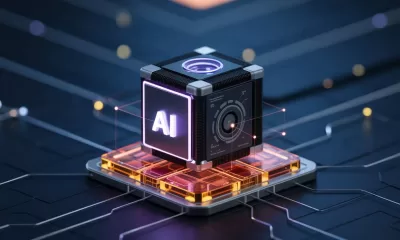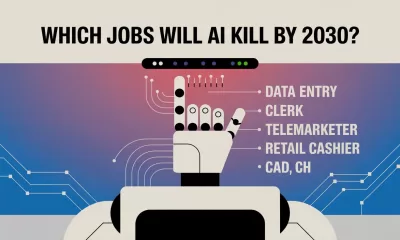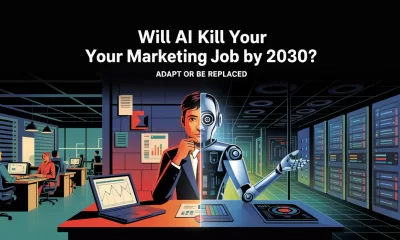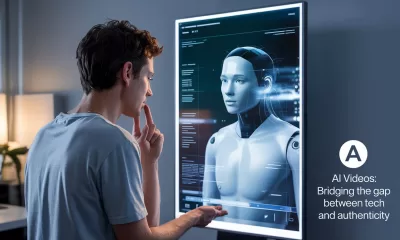Marketing
Revolutionizing Advertising: Meta’s New AI Video Tools
Meta’s new AI video tools are transforming advertising by making it easier to create and edit video content, enhancing user experience and engagement.
Published
6 months agoon
By
AIinAsia
TL;DR:
- Meta is introducing new AI tools for advertisers to create and edit videos.
- These tools will turn static images into video ads and automatically adjust video sizes.
- Over 15 million ads were created using Meta’s generative AI tools last month.
- Facebook and Instagram users now spend 60% of their time watching video content.
In a groundbreaking move, Meta Platforms Inc. is set to revolutionise the advertising landscape with the introduction of new artificial intelligence tools. These tools are designed to help advertisers create and edit videos more efficiently, catering to the growing trend of video consumption on Facebook and Instagram. This development underscores Meta’s commitment to leveraging AI to enhance user experience and boost advertising capabilities.
The Rise of Video Content
Video content has become a dominant force on social media platforms. According to Meta, Facebook and Instagram users now spend 60% of their time watching videos. This shift in user behaviour has prompted Meta to invest heavily in video-centric features. The company is introducing a new video feed on the Facebook app, allowing users to watch videos in full-screen mode. This feed will combine short-form videos called Reels, livestream content, and longer-form videos, providing a seamless and immersive viewing experience.
Meta’s AI Tools for Advertisers
Meta’s new AI tools are set to transform the way advertisers create and manage video content. Here are some key features:
- Generative AI for Video Creation: Advertisers can now use generative AI to turn static images into engaging video ads. This feature will significantly reduce the time and effort required to create compelling video content.
- Automatic Video Editing: The tools will also allow marketers to edit and adjust the size of video ads automatically. This ensures that ads are optimised for different platforms and devices, enhancing their effectiveness.
- Text and Image Generation: Meta already provides tools for automatically creating text and images for ads. These capabilities, combined with the new video features, offer a comprehensive suite for advertisers to create impactful campaigns.
The Impact of AI on Advertising
The integration of AI into advertising is not new for Meta. The company has long used artificial intelligence to help brands find and target their ideal customers. Last month alone, advertisers created over 15 million ads using Meta’s generative AI tools. This highlights the growing reliance on AI to streamline advertising processes and improve outcomes.
The Future of Video Advertising
The new AI tools are part of Meta’s broader strategy to increase user engagement and ad revenue. By making it easier for advertisers to create and manage video content, Meta aims to attract more businesses to its platforms. The company’s push into video aligns with the global trend towards video consumption, positioning Meta at the forefront of digital advertising innovation.
Prompt: Creating a Video Ad with AI
Rationale: To demonstrate the power of Meta’s new AI tools, let’s consider a prompt for creating a video ad. This prompt will help advertisers understand how to leverage generative AI to transform static images into engaging video content.
Prompt: “Create a 15-second video ad for a new line of eco-friendly products. Use the static image of the product and add a voiceover that highlights the product’s benefits. The video should end with a call-to-action encouraging viewers to visit the website for more information.”
The Role of AI in Enhancing User Experience
AI is not just about making advertising easier; it’s about enhancing the user experience. By providing tools that create more engaging and relevant content, Meta is ensuring that users have a better experience on its platforms. This, in turn, increases user engagement and satisfaction, leading to more time spent on the apps and more opportunities for advertisers.
Embracing the Future of Advertising
Meta’s new AI tools represent a significant step forward in the world of digital advertising. By leveraging generative AI to create and edit video content, advertisers can reach a wider audience more effectively. The future of advertising is here, and it’s powered by AI.
Comment and Share:
What do you think about Meta’s new AI tools for video advertising? How do you see AI shaping the future of digital marketing? Share your thoughts in the comments below and subscribe for updates on AI and AGI developments.
- You may also like:
- AI Ads Stir Up Conversations: The Future of Marketing in Asia
- AI Ads Stir Up Conversations: The Future of Marketing in Asia
- Mastering AI Marketing: A Guide for Tech-Savvy Minds in Asia
- To learn more about Meta’s Ai tools for advertisers, tap here.
Author
Discover more from AIinASIA
Subscribe to get the latest posts sent to your email.
You may like
-


The Three AI Markets Shaping Asia’s Future
-


Adobe Jumps into AI Video: Exploring Firefly’s New Video Generator
-


How Singtel Used AI to Bring Generations Together for Singapore’s SG60
-


New York Times Encourages Staff to Use AI for Headlines and Summaries
-


Voice From the Grave: Netflix’s AI Clone of Murdered Influencer Sparks Outrage
-


How Will AI Skills Impact Your Career and Salary in 2025?
Marketing
Will AI Kill Your Marketing Job by 2030?
AI is set to eliminate two-thirds of marketing agency jobs by 2030. Which roles are at risk and how marketers can thrive amid disruption?
Published
2 weeks agoon
April 4, 2025By
AIinAsia
TL;DR – What You Need to Know in 30 Seconds
- AI Revolution: Over two-thirds of marketing agency roles will disappear by 2030, replaced by AI.
- Jobs at Risk: Copywriters, designers, data analysts, and social media managers face immediate disruption.
- Adapt or Die: Marketers must become strategic visionaries and partner with AI, or risk becoming obsolete.
AI and the End of Marketing Professions: Will Your Job Survive the AI Revolution?
We live in a moment Jeremy Rifkin vividly foresaw nearly 30 years ago in The End of Work: technology is not only reshaping jobs but eliminating entire categories. Marketing, traditionally seen as a safe haven for human creativity and analytical intuition, is now being fundamentally disrupted by artificial intelligence (AI). But how dramatic is this shift?
A Marketing Veteran’s Prediction: 2/3 of Jobs Gone by 2030?!
Having worn almost every hat in marketing—from award-winning creative designer, analyst, project manager to CTO—I have a unique perspective on these shifts. By 2030, I predict that more than two-thirds of marketing agency roles will become redundant, radically reshaped by the relentless efficiency of AI. Before you panic, though, let’s clarify something: marketing isn’t dying; it’s evolving.
This is not a doomsday prophecy—it’s a call to action.
Technological Prophecies Come True
Jeremy Rifkin warned us decades ago that automation would first hit repetitive tasks in manufacturing, administration, and services. Similarly, Alvin Toffler’s The Third Wave foresaw a future dominated by information technology disrupting traditional roles.
Today, marketing is riding this “third wave,” with tools like ChatGPT, DALL-E, and GitHub Copilot taking over tasks once believed uniquely human.
Which Marketing Roles Will AI Replace Next?
Here’s a breakdown of marketing professions facing immediate AI-driven disruption:
1. Basic Copywriters
- Why? AI effortlessly churns out slogans, product descriptions, and social posts at lightning speed.
- Example: “Write a catchy slogan for running shoes”—seconds later, AI delivers.
- Insight: Nicholas Carr’s The Shallows argues technology thrives where mediocrity suffices.
2. HTML Designers
- Why? Platforms like Wix and Squarespace empower non-technical users to create visually appealing websites with zero coding.
- Example: Input a few parameters, and AI delivers a polished landing page instantly.
3. Routine Marketing Programmers
- Why? GitHub Copilot and similar tools rapidly generate scripts, eliminating routine coding.
- Example: AI writes a tracking script in minutes that previously took hours.
4. Operational Social Media Managers
- Why? Buffer, Sprout Social, and other tools automate content scheduling, performance analysis, and even post-generation.
- Example: AI optimises posting times and auto-generates captions with minimal human input.
5. Entry-Level Data Analysts
- Why? Intelligent analytics tools (like Google Analytics with AI integration) automate data interpretation and reporting.
- Example: AI produces campaign performance reports and actionable insights without human prompting.
6. Basic Graphic Designers
- Why? Canva and AI image generators (e.g., DALL-E) democratise design capabilities, removing dependence on Photoshop skills.
- Example: Type “summer Instagram ad,” and AI immediately crafts visually appealing ads.
7. PR Assistants
- Why? AI-powered tools automate press releases, manage contact lists, and analyse media coverage without human assistants.
- Example: Meltwater identifies journalists and ChatGPT crafts press releases effortlessly.
8. Media Planners & Experts
- Why? Brandwatch and similar platforms analyse real-time media data to automate strategic media buying.
- Example: AI suggests budget allocation across channels in seconds, outpacing human planners.
9. Influencer Campaign Managers
- Why? AI identifies influencers, analyses their audience relevance, and recommends engagement strategies autonomously.
- Example: Tools like Influencer Marketing Hub streamline influencer discovery and campaign management entirely.
Is Any Marketing Job Safe from AI?
Despite this disruption, there are areas AI currently struggles to penetrate fully: Creative Directors and Illustrators. Kevin Kelly, author of The Inevitable, emphasises that human empathy, nuanced storytelling, and visionary ideas remain beyond AI’s grasp—at least for now.
Yet, even in these creative roles, AI increasingly acts as a powerful assistant, generating preliminary concepts for human refinement. So, while creative leadership roles appear safe today, the line is rapidly blurring.
Embracing AI: From Threat to Ally
As someone who’s navigated every corner of marketing—from the operational trenches to strategic leadership—I view AI as a double-edged sword: it demolishes traditional roles yet creates powerful new opportunities. Rifkin himself argued in The Zero Marginal Cost Society that technology drastically reduces operational costs, driving unparalleled efficiency.
The key: Marketers must see AI as a partner, not a competitor. Those who embrace AI strategically will survive and thrive.
Conclusion: Not the End, But a Radical Reinvention
Marketing isn’t ending—it’s transforming. While roles like basic copywriters, graphic designers, media planners, and PR assistants rapidly become obsolete, a new generation of strategic visionaries will rise.
As Alvin Toffler eloquently put it, “The future is not something that awaits us, but something we create.” For marketers, this means shifting from execution to strategic thinking, turning AI from a threat into our most valuable collaborator.
The question is: Is your marketing job destined for extinction by 2030, or can AI turn you into a marketing visionary?
Share your stories and opinions in the comments section—we’d love to hear from you.
You may also like:
- Forget the panic: AI Isn’t Here to Replace Us—It’s Here to Elevate Our Roles
- The AI Shift: Coping with AI Job Transformation in Asia
- The Mind-Blowing Future of AI: Ray Kurzweil’s Predictions for 2050
- Embrace the evolution now by finding the latest, best free online course for learning marketing with the Marketing AI Institute by tapping here.
Author
Discover more from AIinASIA
Subscribe to get the latest posts sent to your email.
Business
Why are CMOs Still Holding Back on AI Marketing?
The New York Times embraces generative AI for headlines and summaries, sparking staff worries and a looming legal clash over AI’s role in modern journalism.
Published
2 months agoon
March 3, 2025By
AIinAsia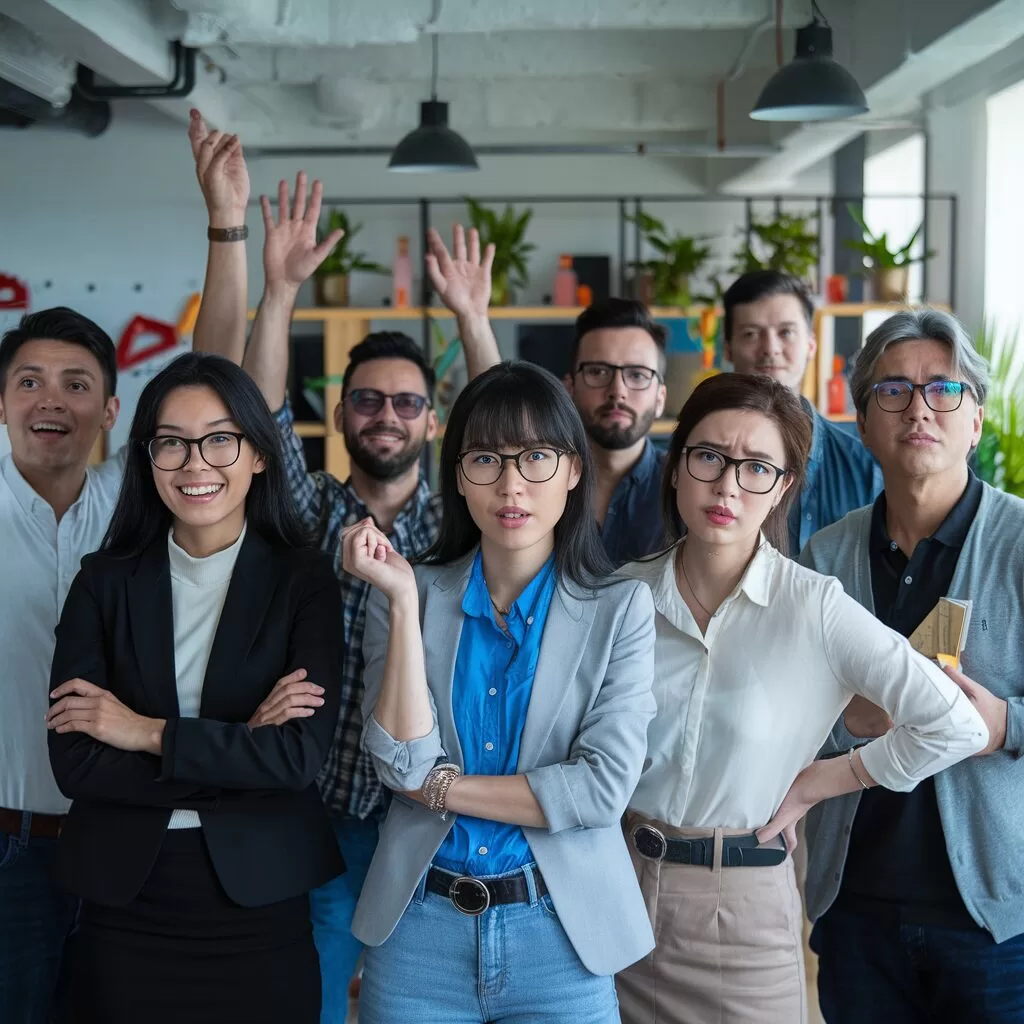
TL;DR – What You Need to Know in 30 Seconds
- Reluctant 27%: A significant chunk of CMOs have minimal or zero use of AI marketing, citing costs and ethical concerns.
- High Performers: Businesses that exceed profit goals are widely using generative AI for both creative work and strategy.
- Cautious Optimism: While some see major wins in campaign analytics, others struggle to find benefits in cost reduction and customer service.
- Risk of Lagging: Experts warn that slow adoption could leave traditional marketers scrambling to catch up in a rapidly evolving field.
Why Are CMOs Still Holding Back on Generative AI Marketing?
In a world where even your local bakery is dabbling with AI-driven marketing campaigns, it seems a little baffling that some Chief Marketing Officers (CMOs) are still on the fence about generative artificial intelligence (AI). The hype machine is running full tilt, with countless headlines promising a revolution in how we strategise and create marketing materials. And yet, according to Gartner’s latest research, 27% of CMOs report no or limited adoption of generative AI in their teams. What’s going on, and should these marketing chiefs be worried? Let’s explore.
The Reluctant Third
Let’s start with the eye-catching number that’s got tongues wagging across the marketing landscape: 27% of CMOs either aren’t using generative AI at all or are only dabbling on the periphery. Considering we’re several years into the generative AI hype wave, you’d think that figure would be lower. After all, we hear success stories about AI-generated ad campaigns or chatbots that transform customer service on a nearly daily basis. So why the reluctance?
One big reason often cited is the cost. While there are open-source options, enterprise-level tools (complete with robust support and advanced data security features) don’t come cheap. Then, there’s also the legal and ethical minefield: some executives worry about brand risk or data security concerns. If your marketing AI is scraping questionable sources for content, or if it accidentally pinches trademarked materials, the cost could be more than just monetary—it might damage your brand’s reputation.
High Performers Blaze the Trail
If you think generative AI is all hype, you might want to pay attention to the marketing teams who are actually succeeding with it. According to Gartner’s findings, 84% of high performers—businesses that exceed their annual profit growth and marketing goals—are leveraging generative AI for creative development, and 52% are putting it towards strategy development.
These stats matter because they highlight a gap between those who’ve embraced the AI revolution and those who are dragging their feet. High-performing organisations see “creative development” as the perfect playground for generative AI: from drafting copy to brainstorming design ideas, the tech is boosting the volume and diversity of creative work. Strategy development is also getting an AI-powered makeover, with marketers crunching campaign data in record time to find winning formulas.
As Gartner notes, CMOs who ignore the technology “are in a position of greater risk.” It’s not just about keeping up with the Joneses—it’s about leveraging a tool that can genuinely make marketing campaigns more efficient, more targeted, and possibly even more profitable.
Not Everyone Sees the Glitter of AI Marketing
Interestingly, the Gartner research also shows that generative AI’s benefits aren’t universally acknowledged. Over a quarter of CMOs surveyed reported little to no benefit in areas like cost reduction, customer service, and scalability. That’s a bit of a head-scratcher when many of us have been sold the dream that AI would turn marketing teams into lean, mean campaigning machines.
Part of the mismatch might come from inflated expectations. Some CMOs might have imagined generative AI swooping in like a marketing superhero, solving every challenge overnight. As a result, when the reality—training, experimenting, refining—sets in, disappointment can ensue.
Many believe GenAI will transform marketing, but despite the hype, many CMOs feel that their GenAI investments have yet to pay off.
It’s also worth noting that 6% of CMOs have no usage of generative AI at all, whereas 21% have only waded into the shallow end. Yet on the other side of the spectrum, around 15% see extremely broad use among their teams. That discrepancy screams caution from some corners and gung-ho enthusiasm from others.
Disruptors and Doubts
Remember those corporate AI solutions that come with hefty price tags? Well, the pace of AI evolution has accelerated massively, especially in Asia. Enter disruptive companies like China’s DeepSeek, which have introduced more affordable—or at least more flexible—versions of AI. They’ve changed the conversation around pricing, data security, and the potential of open-source models.
But not everyone is convinced. A survey by The Wall Street Journal found 21% of IT leaders aren’t currently using AI agents, with reliability being a major sticking point. While that might sound like a small number, keep in mind that these are the folks who sign off on the tech stack. If they harbour doubts, the marketing team’s AI ambitions could remain tethered to a cautionary anchor.
Where Are the Gains?
Despite the reluctance from some, 47% of those who have embraced generative AI are seeing a large benefit in tasks such as campaign evaluation and reporting. This indicates that when deployed properly, AI can absolutely streamline some parts of the marketing machine. Whether it’s quicker insight generation from data analytics or more accurate audience segmentation for targeted campaigns, the gains can’t be ignored.
So, if you find yourself in that 27% who are holding out, consider this: the competitive edge might be slipping away to those high performers who are pairing human creativity with AI efficiency.
Balancing Caution and Curiosity
Let’s be honest: any new technology comes with risks. Data security, ethical boundaries, and steep pricing are real concerns. The key might lie in adopting a balanced approach: start with smaller, safer implementations—like using AI for ad copy testing or initial design mock-ups—before rolling it out to high-stakes areas.
It’s a bit like learning to swim: you wouldn’t jump off the high dive if you’ve never been in the pool before, but you wouldn’t stand on the edge of the pool forever, either.
The Final Word: Ready to Jump In or Watch from the Sidelines?
So, is generative AI in marketing a passing fad or the future of the industry? The data suggests it’s much more than a flash in the pan. High performers are already capitalising on AI’s creative and strategic potential.
The question is: will the sceptics catch up before they’re left behind entirely?
You may also like:
- When Will AI Replace the CMO?
- Revolutionising Marketing: The Impact of AI in Asia’s Business Landscape
- Or try Google’s Gemini by tapping here.
Author
Discover more from AIinASIA
Subscribe to get the latest posts sent to your email.
Marketing
AI Storms the 2025 Super Bowl: Post-Hype Breakdown of the Other Winners and Losers
Discover how AI dominated 2025 Super Bowl ads, from Gemini’s cheese slip-up to OpenAI’s pointillism debut, we assess them all here.
Published
2 months agoon
February 17, 2025By
AIinAsia
TL;DR – What You Need to Know in 30 Seconds
- AI Dominance: The 2025 Super Bowl was flooded with ads showcasing AI, indicating the tech is truly mainstream.
- Google Gemini: A heartfelt dad-and-daughter ad overshadowed an earlier mishap over questionable cheese consumption stats (50–60% for gouda?).
- Salesforce: Matthew McConaughey dashed through Heathrow, highlighting how an autonomous AI agent (Agentforce) could simplify travel chaos.
- Cirkul: Actor Adam Devine poked fun at AI errors by accidentally ordering 100,000 water bottles—then offered 100,000 free ones to viewers.
- OpenAI: Debuted a pointillism-themed Super Bowl ad emphasising innovative leaps and stoking mixed reactions about generative AI’s impact.
- Meta: Promoted Ray-Ban Meta smart glasses in an artsy spot featuring three “Chris” celebrities, a $6.2 million banana, and a gallery trip.
- GoDaddy: Showed off “Airo,” an AI tool for small businesses, starring Walton Goggins, implying you can “fake it till you make it” with AI designs.
- Beyond Tech Giants: Smaller companies like Ramp (supported by Eagles RB Saquon Barkley) also took out ads, proving AI is everywhere.
The Big Picture: Eagles, Ads, and AI Everywhere
Before we break down the ads—and there were plenty worth discussing—let’s set the stage. The Philadelphia Eagles soared to a decisive victory, dismantling the competition on the field (much to the dismay of the opposing team’s fans). Meanwhile, the commercials became a veritable parade of AI: from big-league tech giants to scrappy startups, everyone wanted to show off their shiny new chatbots, generative design tools, or smart glasses.
It wasn’t just the usual suspects like Google and Meta. We also had appearances from CRM titan Salesforce, AI-first marketing from OpenAI, a cheeky cameo from GoDaddy, and even a water bottle brand, Cirkul, poking fun at the occasional “hallucination” AI can produce. If there’s one takeaway, it’s that we’re in an era where AI is no longer just lurking in tech blogs or sci-fi flicks—it’s playing centre stage (or midfield, if you prefer). Now, let’s shuffle the order of these ads to keep things fresh, shall we?
1. Google: Cheese Fiascos and a Heart-Warming Dad Moment | ★★☆☆☆
What Happened:
- Google went sentimental with a father-daughter storyline to show off its Gemini AI. Think last-minute job interviews and sweet pep talks.
- The brand also caught flak for a separate cheese-shop-themed ad. Gemini stated gouda accounted for “50–60%” of global cheese consumption, which turned out to be, well… questionable. Google hastily fixed it, but the internet still had a field day calling it “cheesy AI.”
Industry Take:
- Ad experts found the emotional approach refreshing—less geeky, more real-life.
- The cheese fiasco sparked debate on the dangers of “AI hallucinations.” Jerry Dischler (Google’s cloud apps prez) defended it, saying it came from cheese.com, but folks remained sceptical.
Public Buzz:
- Plenty of “Aww!” reactions to the father-daughter tale.
- Social media teased the “gouda slip-up,” with tweets like “Cheddar’s not impressed.”
Overall:
- Sweet sentiment meets minor embarrassment—but hey, at least we all learned to double-check our cheese facts.
2. Salesforce: Matthew McConaughey Races Through Heathrow | ★★★☆☆
What Happened:
- Matthew McConaughey and Woody Harrelson comedic skits: Matt misses flights, gets soaked, basically endures a travel meltdown because he didn’t use “Agentforce,” Salesforce’s shiny new AI tool.
- Woody smugly coasts by with real-time updates from the AI.
Industry Take:
- Experts liked the “practical AI” angle—showing how it solves actual problems.
- Some found it a tad safe, lacking the pizzazz of other spots. Also, internal chatter about layoffs overshadowing big ad spend caused mild grumbling.
Public Buzz:
- Audiences enjoyed the “True Detective” duo. Many tweeted “Alright, alright, alright, that was kinda cute.”
- Not as viral as the night’s more outrageous ads, but still a respectable comedic performance.
Overall:
- A breezy, Hollywood-friendly way to show AI in everyday life—yet overshadowed by bigger controversies and bigger laughs elsewhere
3. Cirkul: 100,000 Free Water Bottles—and a Big AI Oops | ★★★★½
What Happened:
- Comedian Adam Devine tries to order one water bottle with an AI assistant but ends up with 100,000. Instead of calling it a “glitch,” Cirkul just gave 100,000 away for free—yes, really
Industry Take:
- AdWeek and TechCrunch gave it high marks for turning an AI facepalm into a playful promo.
- Folks loved the real-life activation—giving away freebies turned watchers into happy recipients.
Public Buzz:
- “Wait, are they seriously sending 100,000 bottles?!” soared across Twitter.
- Adam Devine’s panicked comedy vibe won hearts. People were thoroughly hydrated and entertained.
Overall:
- Hilarious scenario with a real giveaway to back it up. One of the game’s feel-good stunts.
4. OpenAI: From Rebrands to Black Dots and Divided Opinions | ★★★☆☆
What Happened:
- OpenAI’s first Super Bowl splash portrayed ChatGPT like the next great invention, complete with dot-by-dot animation referencing human milestones (lightbulb, moon landing, first email)
- Dubbed “The Intelligence Age,” it concluded with the black-and-white visuals morphing into the ChatGPT logo.
Industry Take:
- TechRadar loved the bold style, calling it a “standout moment”
- Some critics worried it felt too lofty or abstract—an epic vibe without a clear product demo.
Public Buzz:
- Mixed. Some folks got goosebumps (“Are we witnessing history?!”), others found it borderline cryptic
- Massive spike in people Googling “What is ChatGPT?” That’s a marketing win right there
5. Meta: Smart Glasses, Bananas, and the Chris Trifecta | ★★★★☆
What Happened:
- Chris Hemsworth, Chris Pratt, and Kris Jenner star in a swanky art gallery caper… except the gallery turns out to be Jenner’s house. Pratt uses the AI glasses to check the art (a banana taped to a wall—nice nod to overpriced modern “art”). Hemsworth devours said banana. Chaos ensues.
Industry Take:
- Campaign called it “celebrity power to the max,” praising the comedic premise.
- Critics said it’s a slick, star-studded way to showcase AR without scaring folks away with too much tech-speak.
Public Buzz:
- Everyone loved the “Chris trifecta.” Memes about Hemsworth literally eating “$6 million worth of banana.”
- Some teased that the storyline was random, but found it funny enough to Google “Ray-Ban Meta glasses.”
Overall:
- A comedic trifecta that made AR glasses look fun and user-friendly.
6. GoDaddy: “Airo,” Goggles, and the Magic of AI Pretence | ★★★★☆
What Happened:
- Walton Goggins plays a clueless entrepreneur hawking “Goggins’ Goggle Glasses,” only to reveal he’s faking it with GoDaddy’s AI tool, Airo.
- It’s basically “fake it till you make it,” courtesy of an AI doing your website, branding, and marketing.
Industry Take:
- Lauded as a clever, comedic twist on small biz struggles—just in 30 seconds.
- Some critics said it might be too “inside joke” if you don’t know Goggins, but overall effective.
Public Buzz:
- People asked, “Who is that hilarious guy??” (He’s been in Justified, Righteous Gemstones, etc.)
- Entrepreneurs found it relatable. Goggins messing up everything from a crime scene to a NASCAR was comedic gold.
Overall:
The Overall Buzz: Fintech, Football, and AI in Everything
Aside from these showstoppers, there were plenty more glimpses of AI scattered throughout the night. Several startups, like Ramp—a fintech company in which Eagles’ running back Saquon Barkley happens to be an investor—also grabbed ad slots. While not necessarily overshadowing the big players, these smaller spots collectively emphasised an important shift: AI is no longer a niche add-on or “special feature.” Instead, it’s woven into the fabric of nearly every tech product we use, whether that’s an email client that suggests replies or a chatbot that checks the weather for you.
It’s also telling that many of these ads had comedic undertones about AI’s potential to err. Whether it’s ordering way too many water bottles or spouting questionable cheese trivia, advertisers seemed eager to show that “yes, AI can be brilliant and even life-changing, but it’s also not perfect.” In a sense, that could be a clever psychological buffer—when users inevitably experience an AI “hiccup” in real life, they might just recall that cheerful commercial that made a joke out of the entire ordeal.
Why This Super Bowl Matters for AI
The 2025 Super Bowl might very well go down in history as the moment AI advertising turned mainstream. Sure, we’ve seen AI in marketing for ages, but rarely in such a brazen, front-and-centre fashion. The cost of a Super Bowl ad alone suggests the confidence these companies have in the technology’s mass appeal. And the variety of participants—OpenAI, Meta, Google, Salesforce, GoDaddy, Cirkul—demonstrates how AI touches virtually every sector, from enterprise software to consumer gadgets to… yes, even your water bottle.
Moreover, this was a chance for big brands to shape the narrative about AI. Whether it’s Google emphasising helpfulness with a father and daughter story, or OpenAI framing ChatGPT as the culmination of centuries of innovation, each brand wants to define why AI matters and how it should be perceived. It’s not just about brand awareness; it’s about public sentiment and trust, which are crucial for technologies that have the potential to radically reshape how we work and live.
The Hype vs. Reality: Are We Expecting Too Much?
One might argue that dropping millions on a 30-second spot for an AI product can create outsized expectations. After all, seeing Chris Hemsworth munching on a banana in Ray-Ban Meta glasses doesn’t necessarily translate into advanced machine learning that flawlessly enriches your daily life. But the Super Bowl has always been a stage for big visions, sensational illusions, and aspirational “could be” scenarios.
At the end of the day, these ads are teasers. They highlight the best of what’s possible, but they don’t always show the messy trials behind the scenes. For instance, Google had to re-edit an ad after the Gemini chatbot gave a suspect cheese stat. AI hallucinations are a genuine issue across the industry, and companies are still grappling with how to best mitigate them. So, yes, the hype is real, but the reality is that AI remains a work in progress (and probably always will be to some extent).
Looking Ahead: AI’s Next Steps After the Game
With all eyes on AI post-Super Bowl, the real question is how these tools will evolve in the coming months. Will Google’s Gemini refine its knowledge base to avoid future cheese fiascos? Will OpenAI’s rebrand continue to dazzle or fade into the background as new generative models surface? Will Meta’s Ray-Bans become a staple of museum-goers, or just another flashy gadget that ends up in a drawer?
The single biggest takeaway is that AI isn’t just for techies. It’s for parents helping their kids, travellers trying to rebook flights, small business owners launching new products, or even Hollywood actors messing around with custom goggles. And with the massive audience that the Super Bowl commands, you can bet the mainstream adoption of AI will only accelerate.
So keep your eyes peeled for more comedic AI slip-ups, more tear-jerking AI success stories, and more heated debates over data privacy, ethics, and job automation. Because if the 2025 Super Bowl taught us anything, it’s that AI is here to stay—and it’s ready to commandeer some of the most prime advertising real estate on the planet.
What do YOU think?
Are we celebrating AI’s mainstream moment too eagerly, risking a reality check once the shiny Super Bowl spotlight fades and the inevitable flaws of AI come back into focus? Let us know in the comments below.
You may also like:
- ChatGPT Prompts for PR Success
- AI Ads Stir Up Conversations: The Future of Marketing in Asia
- Meta’s AI-powered Smart Shades with Ray-Ba
- Or read the game play-by-lay by tapping here.
Author
Discover more from AIinASIA
Subscribe to get the latest posts sent to your email.

AI Career Guide: Land Your Next Job with Our AI Playbook

Will AI Take Your Job—or Supercharge Your Career?

Can AI Videos Really Boost Your Brand’s Authenticity?
Trending
-

 Business3 weeks ago
Business3 weeks agoCan PwC’s new Agent OS Really Make AI Workflows 10x Faster?
-

 Life2 weeks ago
Life2 weeks agoWhich Jobs Will AI Kill by 2030? New WEF Report Reveals All
-

 Life2 weeks ago
Life2 weeks agoAI Career Guide: Land Your Next Job with Our AI Playbook
-

 Business2 weeks ago
Business2 weeks agoWill AI Take Your Job—or Supercharge Your Career?
-

 Marketing2 weeks ago
Marketing2 weeks agoWill AI Kill Your Marketing Job by 2030?
-

 Tools2 weeks ago
Tools2 weeks agoCan AI Videos Really Boost Your Brand’s Authenticity?
-

 Business2 weeks ago
Business2 weeks agoThe Three AI Markets Shaping Asia’s Future
-

 Business3 weeks ago
Business3 weeks agoEmbrace AI or Face Replacement—Grab CEO Anthony Tan’s Stark Warning



















